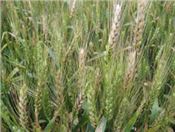|
Wheat Disease Ratings Available From Kentucky Variety Test

Fusarium Head Blight infection
BILL BRUENING
LEXINGTON, KY.
Information on grain yield potential is the primary component sought after when using results from state variety testing programs. Productivity and profitability are directly related to grain yield and varietal selection is recognized as the simplest, most cost effective way to maximize production profitability. Secondary characteristics, such as test weight, straw yield potential, plant height, stem strength, maturity and disease reaction are also important in wheat variety selection decisions.
Varietal disease reaction can be directly related to yield and profitability. A variety’s susceptibility or resistance to a given pathogen can dramatically affect yield and grain quality. The University of Kentucky Small Grains Variety Testing Program annually evaluates the disease reaction among wheat varieties. The types of disease rated can vary annually depending on which pathogen is active in a given growing season/environment. In 2016, disease ratings were recorded for Stripe Rust, Leaf Rust, Septoria Leaf Blotch, and Powdery Mildew http://www2.ca.uky.edu/agcomm/pubs/PR/ PR707/ PR707.pdf .
Disease ratings data can be of value in variety selection decisions, but also in terms of disease management decisions during the growing season. No variety is resistant to all diseases, and it is important to know which varieties are susceptible to a particular disease during an unexpected outbreak. For example in 2016, there was a Stripe Rust outbreak in several regions of Kentucky. Stripe Rust is a pathogen that can rapidly destroy the foliage and dramatically affect grain yield. Growers can utilize variety test disease rating data to determine whether to spray or not spray. For example, in the 2016 Kentucky wheat variety test disease ratings, CROPLAN 9201 was rated 8.3 (highly susceptible) to Stripe Rust and a foliar fungicide would likely be essential for areas with reported infection. CROPLAN 9203, on the other hand, was rated 1.7 (very resistant) and a fungicide would likely not be needed for this disease. In mid-February of 2017, Stripe Rust has been reported in Louisiana and Mississippi. This early observation may be indicative of higher Stripe Rust pressure this year.
The decision to spray fungicide can affect production profitability, certainly in terms of protecting a susceptible variety, but also in terms of savings associated with withholding unneeded fungicide applications and eliminating application costs such as chemical, labor, equipment wear, as well as any environmental effects.
In Kentucky, Head Scab pressure in 2016 was minimal and visual field ratings were not taken. Varieties tested in the UK wheat variety testing program are also evaluated in the UK Fusarium Head Scab Nursery, where the research plots are inoculated with Head Scab pathogen and grown under mist irrigation to favor heavy infection pressure. Results indicating varietal susceptibility and resistance, as well as differences in vomotoxin (DON) levels are available online at the variety testing website www.uky.edu/Ag/WheatVarietyTest . The devastating effects of Head Scab in wheat production is well understood, and utilization of varieties with some level of resistance coupled with fungicide application during flowering is recognized as the best way to minimize yield loss and protect grain quality when environmental conditions favor Head Scab infection.
Results from the University of Kentucky Small Grains Variety Testing program are available online and printed annual reports are available at Kentucky county extension offices. ∆
BILL BRUENING: Research Specialist, University of Kentucky
|
|